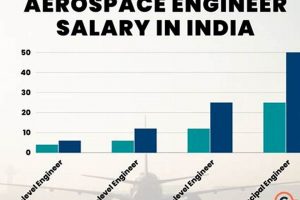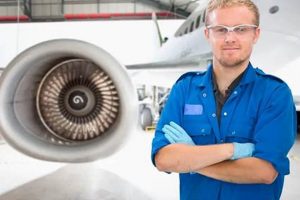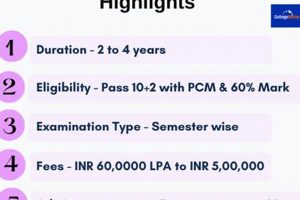A graduate degree in aerospace engineering opens doors to a wide array of specialized roles within the aerospace industry and beyond. Individuals with this advanced qualification are well-equipped to contribute to the design, development, testing, and production of aircraft, spacecraft, satellites, and related systems. The curriculum typically encompasses advanced topics in aerodynamics, propulsion, structural mechanics, control systems, and materials science, providing graduates with a deep understanding of the complex engineering principles underlying aerospace technologies.
Possessing this expertise is crucial for advancing technological innovation in areas such as air travel, space exploration, and national defense. Historically, master’s-level aerospace engineers have been instrumental in developing groundbreaking technologies, from pioneering jet aircraft to enabling human spaceflight. The benefits of this advanced education extend beyond technical proficiency; it also cultivates critical thinking, problem-solving skills, and the ability to manage complex projects attributes highly valued by employers.
Consequently, career paths are diverse, ranging from specialized engineering roles to research and development positions, project management, and even consulting. The following sections will elaborate on some of the specific roles and industries where individuals with this postgraduate qualification can find fulfilling and impactful careers.
Career Advancement Strategies with a Master’s in Aerospace Engineering
The attainment of a Master’s degree in aerospace engineering provides a significant advantage in the competitive job market. To maximize the return on this investment, strategic career planning and professional development are essential.
Tip 1: Specialize in a High-Demand Area: Aerospace engineering encompasses diverse specializations, such as propulsion, aerodynamics, or structural analysis. Focusing on a specific area experiencing high demand, such as hypersonic technologies or autonomous systems, can significantly increase career prospects.
Tip 2: Cultivate Strong Analytical and Problem-Solving Skills: Employers highly value candidates who can effectively analyze complex engineering problems and develop innovative solutions. Emphasize projects and experiences that demonstrate proficiency in these areas on resumes and during interviews.
Tip 3: Gain Practical Experience Through Internships or Research: Practical experience complements academic knowledge. Actively seek internships or research opportunities within the aerospace industry to apply theoretical concepts in real-world settings and build a professional network.
Tip 4: Develop Strong Communication Skills: Aerospace engineers often collaborate with multidisciplinary teams and communicate technical information to non-technical audiences. Honing written and verbal communication skills is crucial for effective collaboration and leadership.
Tip 5: Stay Abreast of Industry Trends and Technological Advancements: The aerospace industry is constantly evolving. Maintain a commitment to lifelong learning by attending industry conferences, reading technical publications, and pursuing professional development courses to stay current with the latest advancements.
Tip 6: Network with Industry Professionals: Building a strong professional network can provide access to valuable career opportunities and mentorship. Attend industry events, join professional organizations such as the AIAA, and connect with professionals on platforms like LinkedIn.
Tip 7: Consider Professional Certifications: Obtaining professional certifications, such as the Professional Engineer (PE) license, can enhance credibility and demonstrate competence in a specific area of aerospace engineering.
By focusing on specialization, skill development, practical experience, continuous learning, and professional networking, individuals with a Master’s degree in aerospace engineering can significantly enhance their career trajectory and achieve their professional goals.
These strategies, combined with a solid academic foundation, will position graduates for success in a dynamic and rewarding field. The next section will provide a conclusion summarizing the overall benefits of this advanced degree.
1. Research and Development
Research and development (R&D) forms a cornerstone of career opportunities accessible with a Master’s degree in aerospace engineering. This advanced degree provides the theoretical foundation and analytical skills necessary to contribute to the advancement of aerospace technologies. The emphasis on innovation and problem-solving inherent in R&D aligns directly with the capabilities cultivated during postgraduate study.
- Fundamental Research in Aerodynamics and Fluid Dynamics
This area involves the exploration of fundamental principles governing fluid flow around aerospace vehicles. Roles encompass developing and validating computational fluid dynamics (CFD) models, conducting wind tunnel experiments to analyze aerodynamic performance, and investigating phenomena such as turbulence and boundary layer effects. The outcomes of this research contribute to improved aircraft design, reduced drag, and enhanced fuel efficiency. A Master’s degree provides the necessary expertise to design and execute complex experiments, analyze large datasets, and publish research findings in peer-reviewed journals.
- Advanced Materials Development
The aerospace industry demands materials with exceptional strength-to-weight ratios, temperature resistance, and durability. R&D efforts in this area focus on developing and characterizing novel materials such as composites, alloys, and ceramics. Engineers with Master’s degrees contribute to the synthesis, processing, and testing of these materials, assessing their suitability for specific aerospace applications. This work is critical for enabling the design of lighter, stronger, and more heat-resistant aerospace structures. This work is crucial for the advancement of space vehicles withstanding spaceflight.
- Propulsion System Innovation
Research and development in propulsion systems aims to improve the efficiency, thrust-to-weight ratio, and environmental impact of aircraft and spacecraft engines. This involves investigating advanced combustion techniques, developing new engine designs, and exploring alternative fuels. Master’s-level engineers contribute to the design and analysis of engine components, conduct simulations to optimize performance, and participate in experimental testing of prototype engines. This area is central to enabling faster air travel, longer-range space missions, and reduced emissions.
- Autonomous Systems and Robotics
The development of autonomous aircraft, spacecraft, and robotic systems is a rapidly growing area of aerospace engineering. R&D in this field involves developing algorithms for navigation, control, and decision-making; designing sensors and actuators for autonomous operation; and integrating these components into complete systems. Engineers with Master’s degrees contribute to the development of sophisticated control systems, sensor fusion algorithms, and artificial intelligence techniques for autonomous aerospace vehicles. This is essential for unmanned aerial vehicles (UAVs), space exploration robots, and autonomous satellite operations.
The multifaceted nature of research and development in aerospace engineering presents a diverse range of opportunities for individuals with a Master’s degree. These roles contribute directly to advancing the state-of-the-art in aerospace technology and addressing the complex challenges facing the industry. Graduates contribute to innovation, sustainability, and national security. This advanced education fosters innovation in the field.
2. Advanced Design Expertise
The attainment of a Master’s degree in aerospace engineering significantly enhances an individual’s design capabilities, opening doors to roles that require a deep understanding of complex systems and innovative design methodologies. This advanced expertise is crucial for the development of next-generation aerospace vehicles and technologies. The ability to synthesize knowledge from various engineering disciplines into cohesive and optimized designs is a hallmark of master’s-level aerospace engineers.
- Conceptual Design and System Architecture
This facet involves the initial stages of aerospace vehicle development, including defining mission requirements, establishing performance goals, and creating preliminary design concepts. Master’s-level engineers apply their knowledge of aerodynamics, propulsion, structures, and control systems to develop feasible and innovative design solutions. For example, designing a new generation of reusable launch vehicles would require expertise in system architecture to integrate propulsion, thermal protection, and guidance systems effectively. This expertise is essential for defining the overall configuration and performance characteristics of aerospace vehicles.
- Detailed Component Design and Analysis
Once a conceptual design is established, detailed component design and analysis becomes critical. This phase involves the precise engineering of individual parts and assemblies, considering factors such as stress, strain, fatigue, and thermal loading. Master’s-level engineers utilize advanced simulation tools and analytical techniques, such as finite element analysis (FEA) and computational fluid dynamics (CFD), to optimize component designs for performance, reliability, and manufacturability. The design of a turbine blade for a jet engine, for instance, requires detailed analysis to ensure it can withstand extreme temperatures and centrifugal forces. The Master’s level offers this advanced knowledge.
- Integration and Optimization of Subsystems
Aerospace vehicles are complex systems comprised of numerous interconnected subsystems. Master’s-level engineers play a vital role in integrating these subsystems to ensure seamless operation and optimized performance. This involves considering factors such as weight distribution, power requirements, and communication protocols. Optimizing the integration of avionics, propulsion, and control systems in an aircraft, for example, requires a holistic understanding of how these subsystems interact and influence overall aircraft performance. A Master’s level enables this systemic view.
- Design for Manufacturing and Sustainability
Modern aerospace design increasingly emphasizes manufacturability and sustainability. Master’s-level engineers must consider manufacturing processes, material selection, and life-cycle costs when designing aerospace components and systems. This involves selecting materials that are both high-performing and environmentally friendly, designing components that can be easily manufactured using existing techniques, and minimizing waste throughout the production process. This design focus is crucial for reducing the environmental impact of the aerospace industry and ensuring long-term economic viability. The sustainability and manufacturability is possible with a master’s degree.
These facets of advanced design expertise, honed through a Master’s program in aerospace engineering, are crucial for securing roles that involve the creation and optimization of aerospace systems. This advanced knowledge provides the ability to contribute to innovative designs, solve complex engineering problems, and lead design teams, ultimately enhancing career prospects and contributions to the aerospace field. This skill is a core function for aerospace engineering profession.
3. Project Leadership
A Master’s degree in aerospace engineering serves as a significant enabler for assuming project leadership roles within the aerospace sector. The advanced technical knowledge, systems-level thinking, and problem-solving skills acquired during postgraduate studies directly translate into the ability to effectively manage complex engineering projects. The aerospace industry frequently undertakes large-scale, multidisciplinary endeavors, such as the development of new aircraft, spacecraft, or satellite systems. Successful completion of these projects necessitates capable leaders who possess both technical competence and managerial acumen. Without a foundation rooted in advanced engineering principles, leading such intricate projects becomes exceedingly challenging.
The curriculum of a Master’s program in aerospace engineering often includes coursework on project management, systems engineering, and decision-making under uncertainty. These courses provide a framework for planning, executing, and controlling aerospace projects within defined constraints of budget, schedule, and performance. Graduates are equipped to define project scope, develop work breakdown structures, allocate resources, manage risks, and track progress. A real-world example includes engineers leading the development of a new satellite constellation for Earth observation. These project leaders are responsible for coordinating the efforts of engineers specializing in areas such as power systems, communications, and structural design, ensuring that the satellite constellation meets its intended mission objectives.
In conclusion, a Master’s degree in aerospace engineering significantly enhances the prospects for assuming project leadership positions. The combination of advanced technical expertise and project management skills prepares graduates to manage complex engineering projects successfully. The demand for technically competent project leaders in the aerospace industry remains high, making this career path a viable and rewarding option for individuals with this advanced qualification. By fostering a deep understanding of the technical intricacies of aerospace systems and equipping engineers with the tools to manage complex projects effectively, the Master’s degree serves as a gateway to leadership roles that shape the future of aerospace technology.
4. Specialized engineering roles
A Master’s degree in aerospace engineering facilitates entry into a range of specialized engineering roles, each demanding a unique blend of advanced knowledge and practical skills. These positions often focus on specific aspects of aerospace vehicle design, development, and operation, requiring expertise beyond the scope of a bachelor’s degree. The enhanced analytical capabilities and problem-solving abilities cultivated during a Master’s program are critical for success in these demanding roles.
- Avionics Engineer
Avionics engineers specialize in the design, development, and testing of electronic systems used in aircraft and spacecraft. This includes navigation systems, communication systems, flight control systems, and radar systems. They must possess a deep understanding of electronics, signal processing, and control theory. For example, an avionics engineer might design a new flight management system for a commercial airliner, ensuring that it meets stringent safety and performance requirements. This role demands a master’s-level understanding of complex electronic systems.
- Propulsion Engineer
Propulsion engineers focus on the design, analysis, and testing of aircraft and spacecraft propulsion systems. This includes gas turbine engines, rocket engines, and electric propulsion systems. They must possess a strong background in thermodynamics, fluid mechanics, and combustion. For instance, a propulsion engineer might work on improving the efficiency of a jet engine or developing a new type of rocket engine for space exploration. The design and optimization of these systems typically require advanced knowledge beyond the scope of undergraduate studies.
- Structural Engineer
Structural engineers are responsible for ensuring the structural integrity of aircraft and spacecraft. This involves analyzing stress, strain, and vibration in aerospace structures, as well as designing and testing structural components. They must possess a deep understanding of structural mechanics, materials science, and finite element analysis. For example, a structural engineer might analyze the stress distribution in an aircraft wing during flight to ensure that it can withstand the aerodynamic loads. These calculations often involve advanced analytical techniques.
- Orbital Mechanics Specialist
Orbital mechanics specialists focus on the analysis and prediction of satellite and spacecraft orbits. This involves using mathematical models and computer simulations to determine the trajectory of a spacecraft, as well as planning orbital maneuvers. They must possess a strong background in physics, mathematics, and astrodynamics. For example, an orbital mechanics specialist might be responsible for planning the trajectory of a satellite to ensure that it remains in its designated orbit. Calculating these trajectories requires an advanced understanding of celestial mechanics.
These examples illustrate the connection between a Master’s degree in aerospace engineering and the attainment of specialized engineering roles. The advanced knowledge and skills acquired during postgraduate studies prepare individuals for careers that demand a deep understanding of complex aerospace systems. Consequently, these specialized roles provide opportunities for significant contributions to the advancement of aerospace technology.
5. Academia and teaching
A Master’s degree in aerospace engineering provides a pathway into academic and teaching positions, enabling individuals to contribute to the education and training of future generations of engineers. This avenue offers opportunities to shape curricula, conduct research, and mentor students, furthering the knowledge base and capabilities of the aerospace field. The advanced knowledge acquired during a Master’s program forms the foundation for effective instruction and scholarly contributions.
- Lecturer or Instructor Roles
Within universities and colleges, individuals with a Master’s degree can secure positions as lecturers or instructors, delivering courses in core aerospace engineering subjects. This involves developing course materials, presenting lectures, conducting laboratory sessions, and assessing student performance. For instance, a graduate with a specialization in propulsion might teach courses on thermodynamics, fluid mechanics, and rocket propulsion, imparting foundational knowledge and practical skills to undergraduate students. These positions offer the chance to directly influence the educational trajectory of aspiring engineers. These role contributes towards advancement in this field.
- Research Assistant or Associate Positions
Many universities employ research assistants or associates to support faculty members in conducting research projects. Individuals with a Master’s degree are well-suited for these roles, contributing to experimental design, data analysis, and the writing of research reports and publications. For example, a graduate with expertise in composite materials might assist a professor in investigating the mechanical properties of new aerospace-grade composites. These positions provide valuable research experience and opportunities to contribute to the advancement of knowledge in specific areas of aerospace engineering. This role provides opportunities to innovate and contribute to development.
- Curriculum Development
Faculty members with a Master’s degree often participate in the development and revision of aerospace engineering curricula. This involves designing new courses, updating existing course content, and ensuring that the curriculum aligns with industry needs and accreditation standards. Graduates may contribute to integrating new technologies, such as advanced simulation software or additive manufacturing techniques, into the curriculum. This role offers the opportunity to shape the educational experience of future aerospace engineers and prepare them for the challenges of the modern aerospace industry. This process ensures that graduates are industry ready.
- Mentoring and Advising Students
Beyond formal teaching responsibilities, faculty members with a Master’s degree often mentor and advise students on academic and career matters. This includes providing guidance on course selection, research opportunities, and career paths. Mentoring can involve assisting students with their senior design projects or providing advice on graduate school applications. This role allows graduates to make a personal impact on the lives of students and contribute to their professional development. By helping them navigate the complexities of their education and career planning, they enable a new generation to reach their goals.
These various facets demonstrate the significant role a Master’s degree in aerospace engineering plays in enabling individuals to pursue academic and teaching careers. These positions provide the opportunity to shape the future of the aerospace industry by educating and mentoring the next generation of engineers. Furthermore, a Master’s-level education is also a stepping stone towards pursuing a doctoral degree and a tenure-track faculty position, further expanding career opportunities in academia.
6. Consulting opportunities
A Master’s degree in aerospace engineering significantly enhances access to consulting opportunities within the aerospace sector and related industries. The advanced technical knowledge, analytical skills, and problem-solving capabilities cultivated through a Master’s program are highly valued by consulting firms and organizations seeking specialized expertise. Consulting roles often require the ability to quickly assess complex technical challenges, develop innovative solutions, and effectively communicate recommendations to clients. Individuals with a Master’s degree are typically well-prepared to meet these demands. For instance, a consultant with this qualification might be engaged by an aircraft manufacturer to optimize the aerodynamic design of a new aircraft wing or by a space agency to develop a risk mitigation strategy for a manned mission to Mars. These engagements directly leverage the deep technical expertise acquired through advanced aerospace engineering coursework.
The scope of consulting opportunities available to aerospace engineers with a Master’s degree is diverse, spanning areas such as aircraft design and certification, spacecraft development, satellite operations, regulatory compliance, and technology assessment. Consultants may work on short-term projects, providing targeted solutions to specific problems, or on long-term engagements, offering ongoing technical support and strategic guidance. A practical example includes a consultant assisting a new space startup with navigating the complex regulatory landscape surrounding satellite launches and operations, ensuring compliance with national and international laws. Further, consulting roles often necessitate strong communication and interpersonal skills, as consultants must interact effectively with clients, stakeholders, and project teams. The ability to articulate complex technical concepts in a clear and concise manner is crucial for conveying recommendations and influencing decision-making.
Ultimately, consulting represents a significant career pathway for individuals holding a Master’s degree in aerospace engineering. The opportunities are wide-ranging, encompassing diverse areas of expertise and project scopes. While challenges exist, such as the need for continuous professional development and adaptation to evolving industry trends, the benefits of a consulting career, including intellectual stimulation, professional growth, and financial rewards, are considerable. This avenue directly connects back to the broader theme of “what can I do with a Master’s in aerospace engineering,” highlighting the degree’s potential to unlock diverse and impactful career options.
7. Government/Defense positions
Government and defense sectors offer substantial career opportunities for individuals holding a Master’s degree in aerospace engineering. These positions often involve working on cutting-edge technologies with significant implications for national security and technological advancement. The rigorous training and specialized knowledge acquired during a Master’s program provide a strong foundation for contributing to the design, development, and testing of advanced aerospace systems within these sectors.
- Research Scientist/Engineer at Government Laboratories
Government laboratories, such as those operated by NASA, the Department of Defense, and the Department of Energy, employ aerospace engineers to conduct research and development in areas such as hypersonic flight, advanced materials, and space exploration technologies. These positions often involve theoretical modeling, experimental testing, and the development of new technologies for military and civilian applications. For example, a research scientist might work on developing new propulsion systems for hypersonic missiles or designing more efficient solar panels for spacecraft. These efforts contribute directly to national security and technological competitiveness.
- Project Manager for Defense Programs
The Department of Defense relies on skilled project managers to oversee the development and acquisition of complex aerospace systems, such as military aircraft, missiles, and satellites. These project managers are responsible for ensuring that projects are completed on time and within budget while meeting stringent performance requirements. A project manager might oversee the development of a new fighter jet, coordinating the efforts of engineers, contractors, and government agencies. This role demands strong technical knowledge, leadership skills, and the ability to manage complex budgets and schedules.
- Aerospace Engineer for Regulatory Agencies
Regulatory agencies, such as the Federal Aviation Administration (FAA), employ aerospace engineers to develop and enforce safety standards for aircraft and air traffic control systems. These engineers conduct technical reviews of aircraft designs, develop regulations to ensure airworthiness, and investigate aviation accidents. For instance, an FAA aerospace engineer might evaluate the safety of a new aircraft design before it is certified for commercial use. These efforts contribute to maintaining the safety and efficiency of the national airspace system.
- Intelligence Analyst specializing in Aerospace Technology
Intelligence agencies, such as the National Reconnaissance Office (NRO), employ analysts with expertise in aerospace technology to monitor and assess foreign aerospace capabilities. These analysts use their knowledge of aerospace engineering principles to evaluate the performance of foreign aircraft, missiles, and satellites, providing critical information to policymakers and military leaders. For example, an intelligence analyst might assess the capabilities of a new Chinese satellite reconnaissance system. These insights inform national security policy and strategic decision-making.
The examples above illustrate the diversity of roles available to individuals with a Master’s degree in aerospace engineering within government and defense sectors. These positions provide opportunities to contribute to national security, technological advancement, and public safety. The specialized knowledge and skills acquired during a Master’s program are highly valued in these fields, making it a strategic career path for those seeking to apply their engineering expertise to serve the nation.
Frequently Asked Questions
This section addresses common inquiries regarding career opportunities available after obtaining a Master’s degree in Aerospace Engineering. The intent is to provide concise and factual responses to common questions.
Question 1: Does a Master’s degree significantly improve job prospects compared to a Bachelor’s degree in Aerospace Engineering?
Yes, a Master’s degree enhances career prospects by providing specialized knowledge and advanced skills. It opens doors to roles involving research and development, advanced design, and project leadership, often inaccessible with only a Bachelor’s degree.
Question 2: What is the typical salary expectation with a Master’s degree in Aerospace Engineering?
Salary expectations vary depending on experience, specialization, and location. However, individuals with a Master’s degree generally command higher salaries than those with only a Bachelor’s degree, reflecting their advanced expertise and potential for greater responsibility.
Question 3: Is a Ph.D. necessary for a career in aerospace research?
While a Ph.D. is often required for leading independent research and holding faculty positions at universities, a Master’s degree is sufficient for many research and development roles in industry and government laboratories. A Master’s provides the necessary analytical and experimental skills to contribute meaningfully to research projects.
Question 4: How important is specialization within Aerospace Engineering at the Master’s level?
Specialization is crucial. Focusing on a specific area, such as propulsion, aerodynamics, or structural mechanics, allows for the development of in-depth expertise, making graduates more competitive for specialized roles within the industry.
Question 5: What non-technical skills are valuable for Aerospace Engineers with a Master’s degree?
Effective communication, teamwork, and project management skills are highly valuable. Aerospace projects are often complex and require collaboration across disciplines, making these non-technical skills essential for success.
Question 6: Is it possible to transition into a different engineering field with a Master’s degree in Aerospace Engineering?
Yes, the strong analytical and problem-solving skills acquired during a Master’s program in Aerospace Engineering are transferable to other engineering fields, such as mechanical, electrical, or systems engineering. However, some additional coursework or training may be necessary depending on the specific field.
In conclusion, obtaining a Master’s degree in Aerospace Engineering represents a strategic investment that can significantly enhance career opportunities and earning potential. Careful consideration of specialization, skill development, and career goals is essential to maximize the return on this investment.
The next section will provide resources for further exploration of career paths and professional development opportunities for Aerospace Engineers.
Conclusion
The preceding exploration underscores the substantial value conferred by a Master’s degree in aerospace engineering. This advanced qualification provides access to a diverse range of specialized and leadership roles within the aerospace industry, government agencies, and academia. The acquisition of advanced technical skills, coupled with enhanced analytical and problem-solving capabilities, positions graduates for impactful contributions across various sectors, from research and development to design, project management, and regulatory oversight. Opportunities for innovation and advancement are significantly amplified through this postgraduate education.
Consequently, individuals considering advanced studies in aerospace engineering should carefully evaluate their interests and career aspirations to optimize their specialization and skill development. The ongoing evolution of the aerospace sector, driven by technological advancements and increasing global demand, necessitates a highly skilled workforce. A Master’s degree provides a crucial competitive advantage, enabling individuals to shape the future of aerospace technology and contribute to advancements that impact society on a global scale. The commitment to continued learning and professional development is essential for sustained success in this dynamic and challenging field.


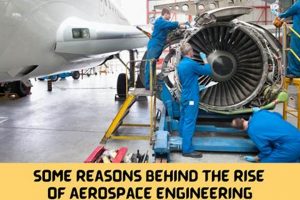
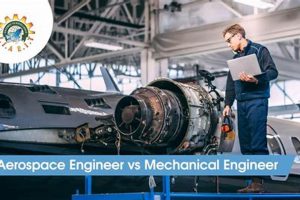
![Top Country for Aerospace Engineering? [A Guide] Innovating the Future of Flight with Reliable Aviation Solutions Top Country for Aerospace Engineering? [A Guide] | Innovating the Future of Flight with Reliable Aviation Solutions](https://mixaerospace.com/wp-content/uploads/2025/11/th-785-300x200.jpg)
